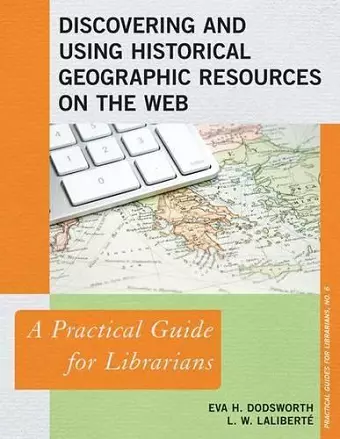Discovering and Using Historical Geographic Resources on the Web
A Practical Guide for Librarians
Eva H Dodsworth author L W Laliberté author
Format:Paperback
Publisher:Rowman & Littlefield
Published:12th Jun '14
Currently unavailable, and unfortunately no date known when it will be back

Historical geographic material, like maps, plans, and air photos, although collected and persevered by libraries, archives, and other heritage organizations, are often hidden from the general public. They can be difficult to find, access, and use. Fortunately, these caches of cartographic gems have been recognized and valued for their significant contribution to research. As a result, many of these collections have been recently digitized and made available to the public, directly and freely, online. Acting as a comprehensive guide to online historical, cartographic and other visual resources, Discovering and Using Historical Geographic Resources on the Web provides library and archival staff, and their users, with information on how to locate, interpret, understand, and use these resources. Even for experts, this book can serve as a handy reference that summarizes the different types of maps published, providing comprehensive lists of where to access them. This book is written for all library staff members who answer reference questions and provide library instruction, and for those who are interested in digitizing their own cartographic collections. It will also attract history buffs and scholars in environmental studies, history, earth sciences, anthropology, and more.
Books about web resources often consist of lengthy lists of long URLs, many of which were out of date before publication. Written by Dodsworth and Laliberté, this new guide to online historical geographic resources is not one of those books. Yes, the book has lists, but they make up only a small portion of the total volume. In addition, most sites listed originate with university libraries or government agencies, which tend to have somewhat more stable URLs. With its detailed descriptions of cartographic resources and the authors’ guidance on the use of those resources, this is a valuable book for librarians. For example, the section on fire insurance maps contains a short history of insurance cartography as well as a brief discussion of color and symbols, scale and corrections, uses in historical research, and a guide to accessing these resources. Overall, this is a very useful introduction to geographic resources (primarily maps and aerial imagery). Although the chapters are brief, they provide adequate summaries of resources. Readers needing more information should consult the reference section located at the end of each chapter. . . .[T]he book is very useful for librarians and others looking for a quick primer on historical cartographic resources located on the web. Summing Up: Recommended. Lower-division undergraduates and above; general readers. * CHOICE *
This is the 6th in title in the Practical Guide for Librarians series, intended to provide help to librarians with planning and implementing new library services and programs. This particular guide, as stated in the preface, introduces the wide variety of options available online for exploring history using geographic information. With the explosion of digitized historical content on the Web, this guide is indeed timely. The first chapter introduces map history in general, along with basic map concepts, and the second explores various online options for locating and retrieving digitized historical maps. Three remaining chapters describe and help users locate historical geographic information, including: surveys and plans; photographic (aerial) images; textual information (e.g., gazetteers, directories, and writings); sound recordings; and other ephemera. The authors emphasize resources produced by libraries and archives in the United States, Canada, and the United Kingdom, but many of these include collections that are global in scope. Each chapter also lists recommended resource by state or province. The resources noted would be useful in supporting research in a variety of disciplines beyond history, including agriculture, natural resources, urban studies, archaeology, and more. This work would be beneficial for new reference and instruction librarians with an interest in historical and geographical resources, or for experienced library professionals looking to expand their reference repertoire. * American Reference Books Annual *
Dodsworth and Laliberte's book is a beautifully produced guide that will help anyone seeking to use historical maps and other cartographic resources on the Web. It is especially useful because it is a comprehensive single point of access to Web resources. -- Danny Dorling, Halford Mackinder Professor of Geography, University of Oxford and honorary president of the Society of Cartographers
If you have ever looked at a historic map and thought, ‘This is great, but I don't understand it!’, Discovering and Using Historical Geographic Resources on the Web is for you. Dodsworth and LaLiberté unfold the mystery behind digital historical maps, so that you, as an educator or library professional, can help your users apply these maps effectively in their studies, research, and everyday lives. -- Rosa Orlandini, president of the Association of Canadian Map Libraries and Archives
ISBN: 9780810891449
Dimensions: 278mm x 217mm x 9mm
Weight: 408g
138 pages